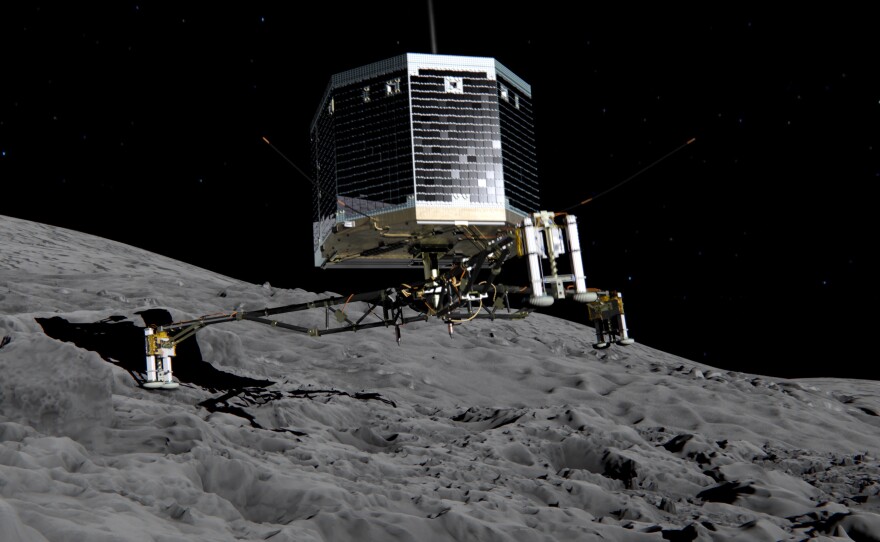Hundreds of millions of miles from Earth, a man-made object was flung at a comet Wednesday — and now it's sticking to the rock as it hurtles through space.
The news came after the European Space Agency endured tense hours of doubt following the lander's separation from the Rosetta spacecraft, as scientists awaited a message from the lander that would tell them whether it landed safely — or suffered a calamity.
It took 10 years for the Philae lander to reach a point where it could be sent toward Comet 67P/Churyumov-Gerasimenko. The ESA said this morning that it had received a signal from the lander as it headed toward its rendezvous with the comet, indicating that if all went well, the lander would be able to communicate and send photos from the comet's surface.
We'll update this post with developments from space. You can also follow the news at the ESA's Rosetta page, and at NASA TV, starting at 9 a.m. ET.
Update at 11:05 a.m. ET: Philae Has Landed
In a first, the Philae lander is on the comet's surface. We've updated the top of this post to reflect the news.
Update at 10:15 a.m. ET: New Images, And 'A Boot'
"Everything looks really, really good," says Stephan Ulamec, Philae program manager at DLR, in a progress report.
The ESA has released new images from the area around the comet, including one shot of Philae breaking away from the Rosetta craft and heading toward 67P.
Another image shows the lander from the view of its parent spacecraft.
The two scientists who discovered the comet 45 years ago — Klim Ivanovych Churyumov and Svetlana Ivanovna Gerasimenko — are in the unique position today of watching humanity's attempt to land on it.
The two scientists are part of an event hosted by the ESA that's equal parts news conference and viewing party.
When Gerasimenko was asked the tongue-in-cheek question of how she likes the comet that she and her colleague spotted decades ago, she responded by saying, "I like the form very much — it reminds me of a boot."
Our original post continues:
Comet 67P has several surprising qualities. First of all, it smells really bad.
"It stinks," researcher Kathrin Altwegg told NPR's Geoff Brumfiel last month.
That's because of a mixture of ammonia, hydrogen sulphide, formaldehyde and methanol.
The comet also emits "a mysterious song," according to the ESA blog.
"The comet seems to be emitting a 'song' in the form of oscillations in the magnetic field in the comet's environment," the ESA says. "It is being sung at 40-50 millihertz, far below human hearing, which typically picks up sound between 20 Hz and 20 kHz. To make the music audible to the human ear, the frequencies have been increased by a factor of about 10,000."
As Geoff reports, scientists here on Earth see Philae, which is about the size of a refrigerator, as "our remote hands." The lander will take many readings from the comet's surface, in addition to drilling into it.
But before any tests can occur, Geoff notes, the comet's rocky and uneven surface could make the landing very tricky — and that's why the lander has harpoons.
"Moments after its feet touch down, the harpoons will fire," Geoff says, "along with some thrusters to keep the lander grounded. Then screws in the feet will try to get a grip."
Copyright 2014 NPR. To see more, visit http://www.npr.org/.






